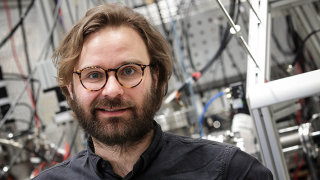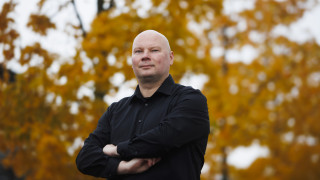Dissertation: Studying the quark matter with small and large collision systems (Virta)

All known matter is composed of atoms, whose nuclei consist of protons and neutrons. These so-called nucleons, in turn, are made up of even smaller constituents called quarks. In everyday conditions, quarks are confined within nucleons and cannot move freely.
Only high-energy heavy-ion colliders can create the extreme conditions required to free quarks from the protons and neutrons inside atomic nuclei. There are only a few such colliders in the world — one in the United States at Brookhaven National Laboratory, called the Relativistic Heavy Ion Collider (RHIC), and another in Switzerland at CERN, called the Large Hadron Collider (LHC).
Matter in extreme conditions
In his doctoral study M.Sc. Maxim Virta explores how matter behaves under the most extreme conditions imaginable – when ordinary protons and neutrons dissolve into quarks and gluons. This exotic state of matter, known as the quark–gluon plasma (QGP), helps scientists understand what the Universe was like just microseconds after the Big Bang.
The research was carried out within the international ALICE experiment at CERN’s Large Hadron Collider (LHC). Maxim Virta analysed high-energy heavy-ion collisions and theoretical model calculations to investigate how the quark–gluon plasma forms, expands, and cools. The results also provide new insights into the internal structure of atomic nuclei, including evidence that the xenon-129 nucleus has an ellipsoidal and triaxial shape.
“The quark–gluon plasma offers a window into the very first moments of the Universe – a time when matter was still in its most fundamental form,” says Virta.
Advanced Analytical Methods
The research goes beyond traditional experimental work by utilizing broad measurements combined with Bayesian analysis. This approach enables simultaneous analysis of multiple observables to extract more precise information about both QGP properties and nuclear structure, while systematically quantifying uncertainties and constraining theoretical models more effectively.
The findings advance our understanding of strongly interacting matter under extreme temperatures and densities and challenge existing theoretical models. This work contributes to the broader effort of the ALICE Collaboration to characterise the properties of the QGP and refine models of nuclear structure and dynamics
M.Sc. Maxim Virta defends his doctoral dissertation "Investigating the QCD matter properties with measurements from various collision systems" at the Department of Physic at the University of Jyväskylä (lecture hall FYS1) on October 24th at 12 o'clock. Opponent is Professor Sangyong Jeon from McGill University and custos is Senior Lecturer Dong Jo Kim from the University of Jyväskylä. The language of the event is English.




